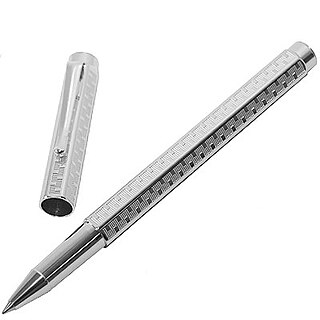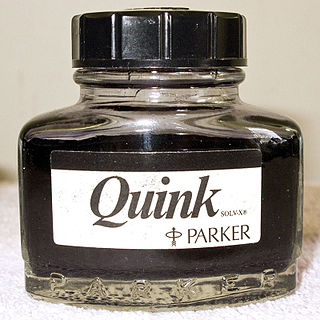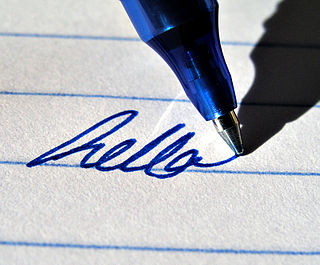
A ballpoint pen, also known as a biro, ball pen, or dot pen (Nepali) is a pen that dispenses ink over a metal ball at its point, i.e. over a "ball point". The metal commonly used is steel, brass, or tungsten carbide. The design was conceived and developed as a cleaner and more reliable alternative to dip pens and fountain pens, and it is now the world's most-used writing instrument; millions are manufactured and sold daily. It has influenced art and graphic design and spawned an artwork genre.

A fountain pen is a writing instrument which uses a metal nib to apply a water-based ink to paper. It is distinguished from earlier dip pens by using an internal reservoir to hold ink, eliminating the need to repeatedly dip the pen in an inkwell during use. The pen draws ink from the reservoir through a feed to the nib and deposits the ink on paper via a combination of gravity and capillary action. Filling the reservoir with ink may be achieved manually, via the use of an eyedropper or syringe, or via an internal filling mechanism which creates suction or a vacuum to transfer ink directly through the nib into the reservoir. Some pens employ removable reservoirs in the form of pre-filled ink cartridges.

A pen is a common writing instrument that applies ink to a surface, usually paper, for writing or drawing. Early pens such as reed pens, quill pens, dip pens and ruling pens held a small amount of ink on a nib or in a small void or cavity which had to be periodically recharged by dipping the tip of the pen into an inkwell. Today, such pens find only a small number of specialized uses, such as in illustration and calligraphy. Reed pens, quill pens and dip pens, which were used for writing, have been replaced by ballpoint pens, rollerball pens, fountain pens and felt or ceramic tip pens. Ruling pens, which were used for technical drawing and cartography, have been replaced by technical pens such as the Rapidograph. All of these modern pens contain internal ink reservoirs, such that they do not need to be dipped in ink while writing.

László József Bíró, Hispanicized as Ladislao José Biro, was a Hungarian-Argentine inventor who patented the first commercially successful modern ballpoint pen. The first ballpoint pen had been invented roughly 50 years earlier by John J. Loud, but it was not a commercial success.

A marker pen, fine liner, marking pen, felt-tip pen, felt pen, flowmarker, sign pen, vivid, texta, sketch pen or koki, is a pen which has its own ink source and a tip made of porous, pressed fibers such as felt. A marker pen consists of a container and a core of an absorbent material... This filling serves as a carrier for the ink. The upper part of the marker contains the nib that was made in earlier times of a hard felt material, and a cap to prevent the marker from drying out.

The Parker Pen Company is a French manufacturer of luxury writing pens, founded in 1888 by George Safford Parker in Janesville, Wisconsin, United States. In 2011 the Parker factory at Newhaven, East Sussex, England, was closed, and its production transferred to Nantes, France.

The Parker 51 is a fountain pen first introduced in 1941. Parker marketed it as “The World’s Most Wanted Pen,” a slogan alluding to restrictions on production of consumer goods for civilian markets in the United States during World War II. Parker's continual advertising during the war created demand that took several years to fulfil after the end of the conflict.
The Waterman Pen Company is a major manufacturing company of luxury fountain pens and inks, based in Paris, France. The firm was established in 1884 in New York City by Lewis Waterman, being one of the few remaining first-generation fountain pen companies, as "Waterman S.A."

Quink is a fountain pen ink developed by the Parker Pen Company. It was introduced in 1931 and has remained in production ever since.
Namiki is a Japanese brand of writing implements, most specifically, fountain pens, owned by the Pilot Corporation. Namiki is mostly famous for its handmade maki-e designs on urushi-based lacquers.

Roller ball pens or roll pens are pens which use ball point writing mechanisms with water-based liquid or gelled ink, as opposed to the oil-based viscous inks found in ballpoint pens. These less viscous inks, which tend to saturate more deeply and more widely into paper than other types of ink, give roller ball pens their distinctive writing qualities. The writing point is a tiny ball, usually 0.5 or 0.7 mm in diameter, that transfers the ink from the reservoir onto the paper as the pen moves.

The Parker Jotter is the Parker Pen Company's second and best-selling retracting refillable ballpoint pen. The first was the Hopalong Cassidy ballpoint.. Since 1954, over 750 million have been sold worldwide. It is priced between $6 for lower end models, and $20 for higher end models, such as special editions. Its refill has a ballpoint tip originally called the T-Ball, with a unique textured surface that greatly reduces slipping and failure to transfer ink onto slick paper, known as "skipping." The technology is now commonly used in the pen industry. The pens are also a popular advertising medium. The external design of the Parker T-Ball refill is a configuration copied by many other brands of refillable pens.
Lamy is a German pen manufacturing company. Josef Lamy, who was a sales representative for Parker Pen in Germany, founded the business in 1930 by purchasing the Orthos pen manufacturer. Lamy was a pioneer in the use of moulded synthetic plastics to make their products.

The BIC Cristal is an inexpensive, disposable ballpoint pen mass-produced and sold by Société Bic of Clichy, Hauts-de-Seine, France. It was introduced in December 1950 and is the best-selling pen in the world, with the 100 billionth sold in September 2006. It has become the archetypal ballpoint pen and is considered ubiquitous, to the extent that the Museum of Modern Art has made it a permanent part of its collection. Its hexagonal form and design mimics a standard pencil and it is sold in six types of point and 18 colours around the world.

Zebra Co., Ltd. is a Japanese manufacturer of writing instruments, established in 1914 by Tokumatsu Ishikawa.

The Marlin Model 1894 is a lever-action repeating rifle introduced in 1894 by the Marlin Firearms Company of North Haven, Connecticut. At its introduction the rifle came with a 24-inch barrel and was chambered for a variety of rounds such as .25-20 Winchester, .32-20 Winchester, .38-40, and .44-40. Variants in other chamberings remain in production today.

A nib is the part of a quill, dip pen, fountain pen, ball point or stylus which comes into contact with the writing surface in order to deposit ink. Different types of nibs vary in their purpose, shape and size, as well as the material from which they are made.

Onoto is a British brand of luxury fountain pens and accessories. Originally manufactured by De La Rue from 1905 until 1958, the brand was relaunched by "The Onoto Pen Company Limited", based in Colney Hall, Norwich in 2005. Onoto pens have been used by numerous notable people from history such as Field Marshal Douglas Haig and Prime Minister Winston Churchill. Other famous names include Florence Nightingale, Edgar Wallace and Natsume Soseki, the foremost Japanese novelist of the Meiji Era.
Sheaffer Pen Corporation is an American manufacturing company of writing instruments, particularly luxury fountain pens. The company was founded by Walter A. Sheaffer in Fort Madison, Iowa, and incorporated in 1913 to exploit his invention of a lever-filling fountain pen. The brand was sold by French company Bic to A. T. Cross Company in August, 2014.
William B. Purvis was an African-American inventor and businessman who received multiple patents in the late 1800s. His inventions included improvements on paper bags, an updated fountain pen design, improvement to the hand stamp, and a close-conduit electric railway system.


















